Project Information System: Project Management Detailed Report
VerifiedAdded on 2023/06/08
|10
|2668
|60
Report
AI Summary
This report provides a detailed overview of project management within an information system context. It begins by outlining the project management lifecycle, divided into five key phases: initiation, planning, execution, monitoring and controlling, and closing. The report then explores ten critical project management areas, including integration, scope, time, cost, quality, procurement, human resources, communications, risk management, and stakeholder management. A project quality control management plan is presented, emphasizing the importance of client satisfaction and adherence to quality objectives, standards, and the use of appropriate tools. The report also identifies potential threats to project success, such as technical problems, cost overruns, and inadequate technological infrastructure. Furthermore, it addresses legal and ethical issues, particularly data security, and underscores the significance of the closing phase in ensuring project completeness and client satisfaction. The report concludes by reiterating the importance of information security and thorough documentation throughout the project lifecycle. Desklib provides access to this and other solved assignments to aid students in their studies.

Running head: PROJECT INFORMATION SYSTEM
Project Information System
Name of the Student
Name of the University
Author Note
Project Information System
Name of the Student
Name of the University
Author Note
Paraphrase This Document
Need a fresh take? Get an instant paraphrase of this document with our AI Paraphraser
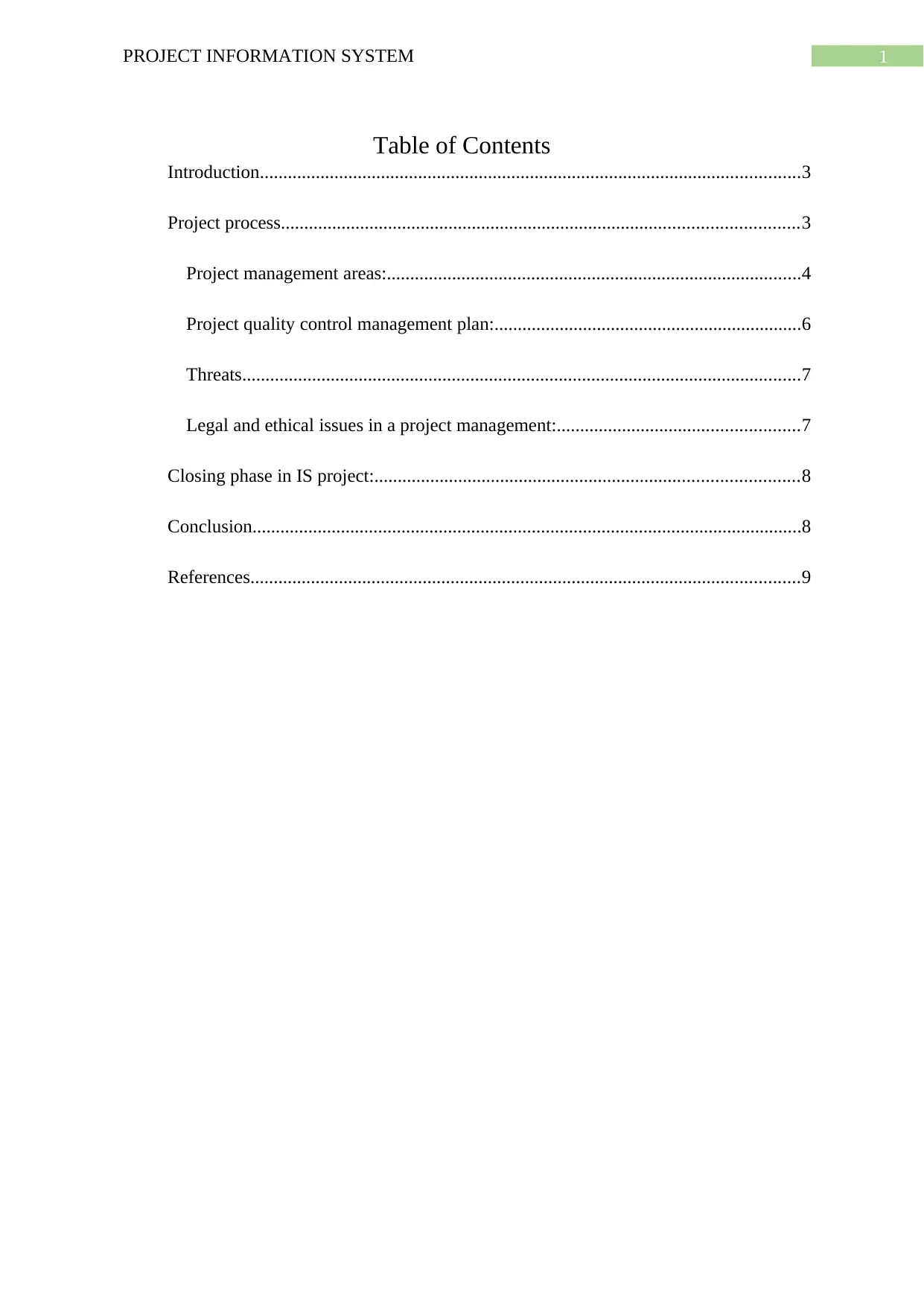
1
Table of Contents
Introduction....................................................................................................................3
Project process...............................................................................................................3
Project management areas:.........................................................................................4
Project quality control management plan:..................................................................6
Threats........................................................................................................................7
Legal and ethical issues in a project management:....................................................7
Closing phase in IS project:...........................................................................................8
Conclusion......................................................................................................................8
References......................................................................................................................9
PROJECT INFORMATION SYSTEM
Table of Contents
Introduction....................................................................................................................3
Project process...............................................................................................................3
Project management areas:.........................................................................................4
Project quality control management plan:..................................................................6
Threats........................................................................................................................7
Legal and ethical issues in a project management:....................................................7
Closing phase in IS project:...........................................................................................8
Conclusion......................................................................................................................8
References......................................................................................................................9
PROJECT INFORMATION SYSTEM
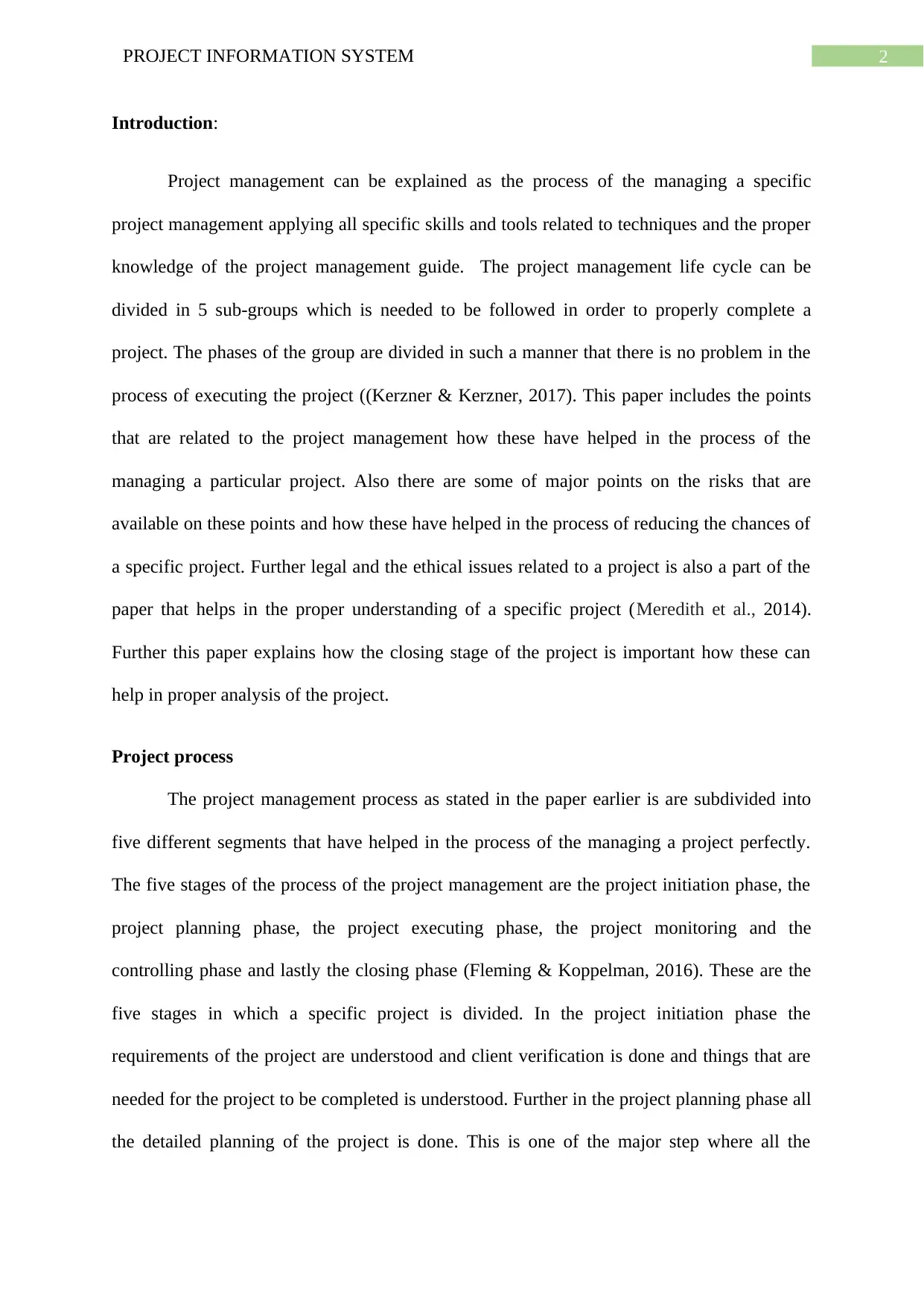
2
Introduction:
Project management can be explained as the process of the managing a specific
project management applying all specific skills and tools related to techniques and the proper
knowledge of the project management guide. The project management life cycle can be
divided in 5 sub-groups which is needed to be followed in order to properly complete a
project. The phases of the group are divided in such a manner that there is no problem in the
process of executing the project ((Kerzner & Kerzner, 2017). This paper includes the points
that are related to the project management how these have helped in the process of the
managing a particular project. Also there are some of major points on the risks that are
available on these points and how these have helped in the process of reducing the chances of
a specific project. Further legal and the ethical issues related to a project is also a part of the
paper that helps in the proper understanding of a specific project (Meredith et al., 2014).
Further this paper explains how the closing stage of the project is important how these can
help in proper analysis of the project.
Project process
The project management process as stated in the paper earlier is are subdivided into
five different segments that have helped in the process of the managing a project perfectly.
The five stages of the process of the project management are the project initiation phase, the
project planning phase, the project executing phase, the project monitoring and the
controlling phase and lastly the closing phase (Fleming & Koppelman, 2016). These are the
five stages in which a specific project is divided. In the project initiation phase the
requirements of the project are understood and client verification is done and things that are
needed for the project to be completed is understood. Further in the project planning phase all
the detailed planning of the project is done. This is one of the major step where all the
PROJECT INFORMATION SYSTEM
Introduction:
Project management can be explained as the process of the managing a specific
project management applying all specific skills and tools related to techniques and the proper
knowledge of the project management guide. The project management life cycle can be
divided in 5 sub-groups which is needed to be followed in order to properly complete a
project. The phases of the group are divided in such a manner that there is no problem in the
process of executing the project ((Kerzner & Kerzner, 2017). This paper includes the points
that are related to the project management how these have helped in the process of the
managing a particular project. Also there are some of major points on the risks that are
available on these points and how these have helped in the process of reducing the chances of
a specific project. Further legal and the ethical issues related to a project is also a part of the
paper that helps in the proper understanding of a specific project (Meredith et al., 2014).
Further this paper explains how the closing stage of the project is important how these can
help in proper analysis of the project.
Project process
The project management process as stated in the paper earlier is are subdivided into
five different segments that have helped in the process of the managing a project perfectly.
The five stages of the process of the project management are the project initiation phase, the
project planning phase, the project executing phase, the project monitoring and the
controlling phase and lastly the closing phase (Fleming & Koppelman, 2016). These are the
five stages in which a specific project is divided. In the project initiation phase the
requirements of the project are understood and client verification is done and things that are
needed for the project to be completed is understood. Further in the project planning phase all
the detailed planning of the project is done. This is one of the major step where all the
PROJECT INFORMATION SYSTEM
⊘ This is a preview!⊘
Do you want full access?
Subscribe today to unlock all pages.

Trusted by 1+ million students worldwide
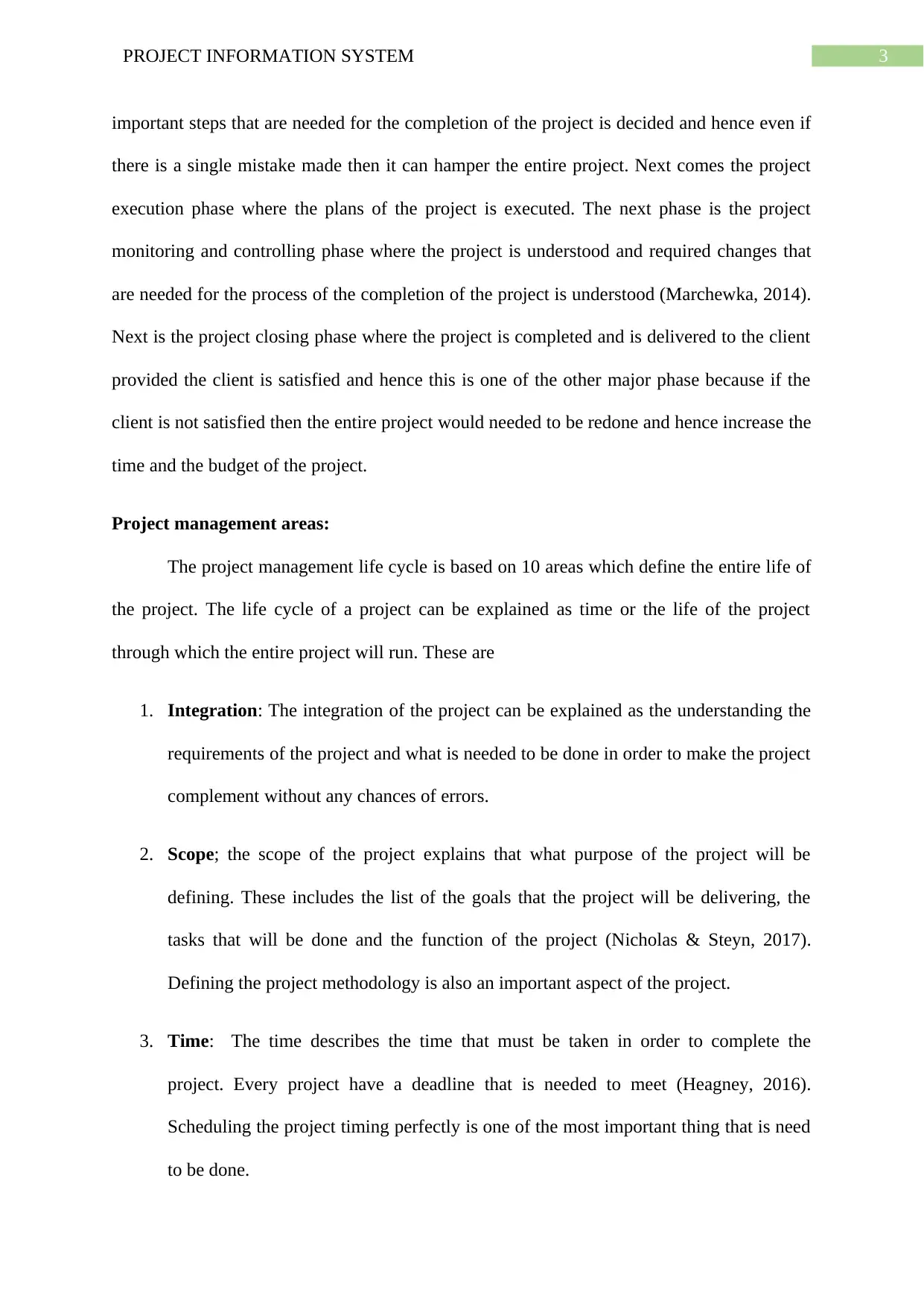
3
important steps that are needed for the completion of the project is decided and hence even if
there is a single mistake made then it can hamper the entire project. Next comes the project
execution phase where the plans of the project is executed. The next phase is the project
monitoring and controlling phase where the project is understood and required changes that
are needed for the process of the completion of the project is understood (Marchewka, 2014).
Next is the project closing phase where the project is completed and is delivered to the client
provided the client is satisfied and hence this is one of the other major phase because if the
client is not satisfied then the entire project would needed to be redone and hence increase the
time and the budget of the project.
Project management areas:
The project management life cycle is based on 10 areas which define the entire life of
the project. The life cycle of a project can be explained as time or the life of the project
through which the entire project will run. These are
1. Integration: The integration of the project can be explained as the understanding the
requirements of the project and what is needed to be done in order to make the project
complement without any chances of errors.
2. Scope; the scope of the project explains that what purpose of the project will be
defining. These includes the list of the goals that the project will be delivering, the
tasks that will be done and the function of the project (Nicholas & Steyn, 2017).
Defining the project methodology is also an important aspect of the project.
3. Time: The time describes the time that must be taken in order to complete the
project. Every project have a deadline that is needed to meet (Heagney, 2016).
Scheduling the project timing perfectly is one of the most important thing that is need
to be done.
PROJECT INFORMATION SYSTEM
important steps that are needed for the completion of the project is decided and hence even if
there is a single mistake made then it can hamper the entire project. Next comes the project
execution phase where the plans of the project is executed. The next phase is the project
monitoring and controlling phase where the project is understood and required changes that
are needed for the process of the completion of the project is understood (Marchewka, 2014).
Next is the project closing phase where the project is completed and is delivered to the client
provided the client is satisfied and hence this is one of the other major phase because if the
client is not satisfied then the entire project would needed to be redone and hence increase the
time and the budget of the project.
Project management areas:
The project management life cycle is based on 10 areas which define the entire life of
the project. The life cycle of a project can be explained as time or the life of the project
through which the entire project will run. These are
1. Integration: The integration of the project can be explained as the understanding the
requirements of the project and what is needed to be done in order to make the project
complement without any chances of errors.
2. Scope; the scope of the project explains that what purpose of the project will be
defining. These includes the list of the goals that the project will be delivering, the
tasks that will be done and the function of the project (Nicholas & Steyn, 2017).
Defining the project methodology is also an important aspect of the project.
3. Time: The time describes the time that must be taken in order to complete the
project. Every project have a deadline that is needed to meet (Heagney, 2016).
Scheduling the project timing perfectly is one of the most important thing that is need
to be done.
PROJECT INFORMATION SYSTEM
Paraphrase This Document
Need a fresh take? Get an instant paraphrase of this document with our AI Paraphraser
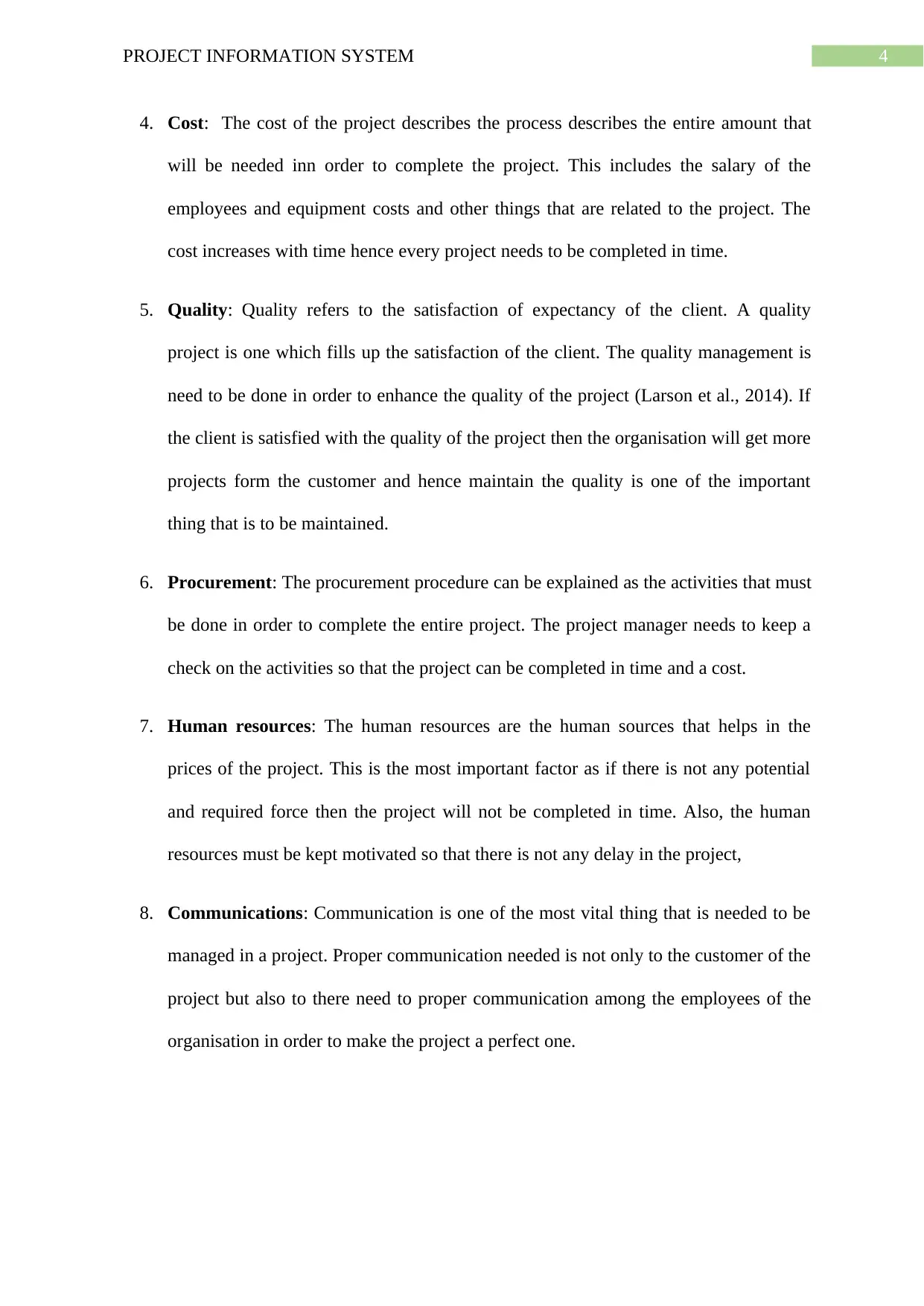
4
4. Cost: The cost of the project describes the process describes the entire amount that
will be needed inn order to complete the project. This includes the salary of the
employees and equipment costs and other things that are related to the project. The
cost increases with time hence every project needs to be completed in time.
5. Quality: Quality refers to the satisfaction of expectancy of the client. A quality
project is one which fills up the satisfaction of the client. The quality management is
need to be done in order to enhance the quality of the project (Larson et al., 2014). If
the client is satisfied with the quality of the project then the organisation will get more
projects form the customer and hence maintain the quality is one of the important
thing that is to be maintained.
6. Procurement: The procurement procedure can be explained as the activities that must
be done in order to complete the entire project. The project manager needs to keep a
check on the activities so that the project can be completed in time and a cost.
7. Human resources: The human resources are the human sources that helps in the
prices of the project. This is the most important factor as if there is not any potential
and required force then the project will not be completed in time. Also, the human
resources must be kept motivated so that there is not any delay in the project,
8. Communications: Communication is one of the most vital thing that is needed to be
managed in a project. Proper communication needed is not only to the customer of the
project but also to there need to proper communication among the employees of the
organisation in order to make the project a perfect one.
PROJECT INFORMATION SYSTEM
4. Cost: The cost of the project describes the process describes the entire amount that
will be needed inn order to complete the project. This includes the salary of the
employees and equipment costs and other things that are related to the project. The
cost increases with time hence every project needs to be completed in time.
5. Quality: Quality refers to the satisfaction of expectancy of the client. A quality
project is one which fills up the satisfaction of the client. The quality management is
need to be done in order to enhance the quality of the project (Larson et al., 2014). If
the client is satisfied with the quality of the project then the organisation will get more
projects form the customer and hence maintain the quality is one of the important
thing that is to be maintained.
6. Procurement: The procurement procedure can be explained as the activities that must
be done in order to complete the entire project. The project manager needs to keep a
check on the activities so that the project can be completed in time and a cost.
7. Human resources: The human resources are the human sources that helps in the
prices of the project. This is the most important factor as if there is not any potential
and required force then the project will not be completed in time. Also, the human
resources must be kept motivated so that there is not any delay in the project,
8. Communications: Communication is one of the most vital thing that is needed to be
managed in a project. Proper communication needed is not only to the customer of the
project but also to there need to proper communication among the employees of the
organisation in order to make the project a perfect one.
PROJECT INFORMATION SYSTEM
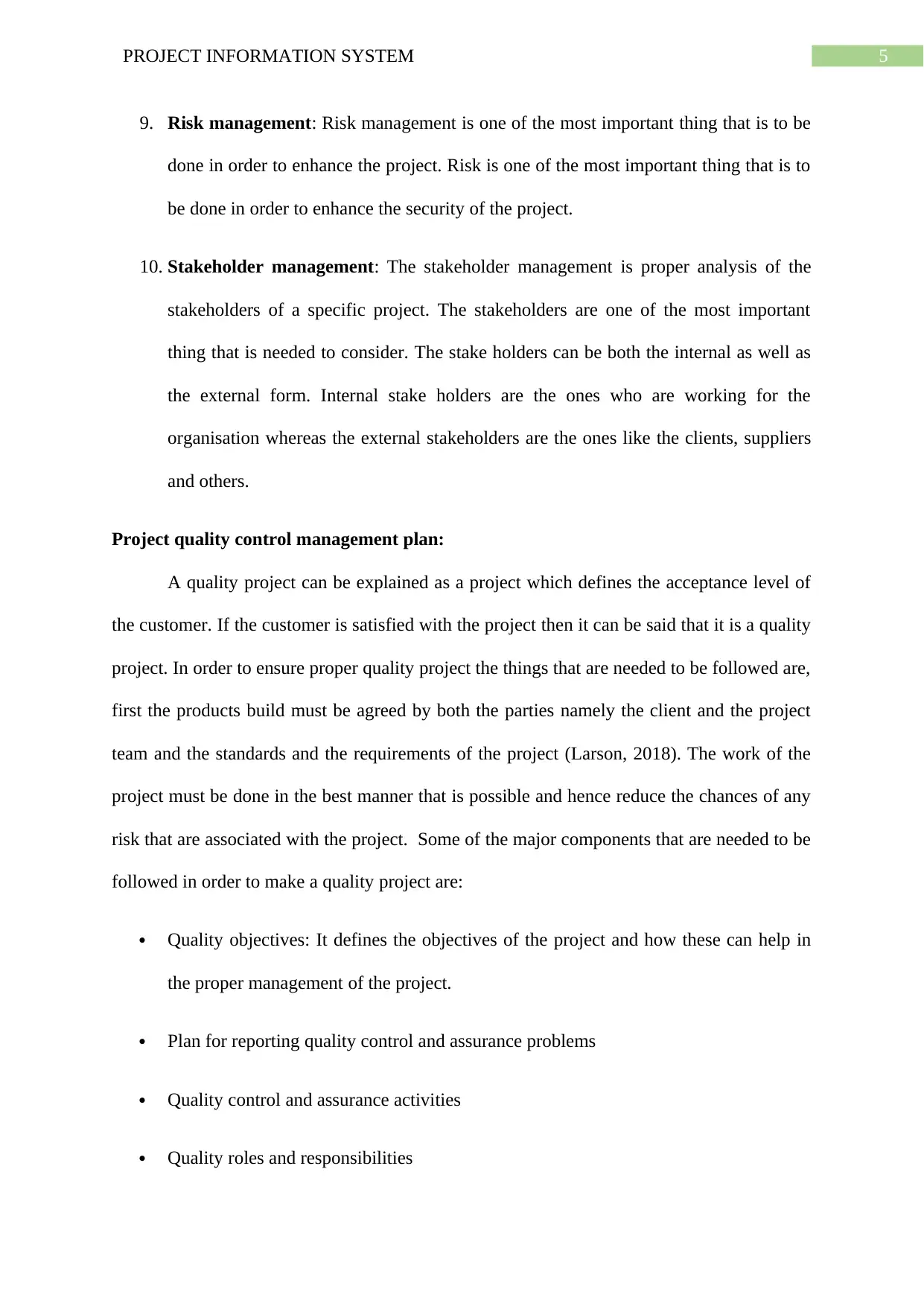
5
9. Risk management: Risk management is one of the most important thing that is to be
done in order to enhance the project. Risk is one of the most important thing that is to
be done in order to enhance the security of the project.
10. Stakeholder management: The stakeholder management is proper analysis of the
stakeholders of a specific project. The stakeholders are one of the most important
thing that is needed to consider. The stake holders can be both the internal as well as
the external form. Internal stake holders are the ones who are working for the
organisation whereas the external stakeholders are the ones like the clients, suppliers
and others.
Project quality control management plan:
A quality project can be explained as a project which defines the acceptance level of
the customer. If the customer is satisfied with the project then it can be said that it is a quality
project. In order to ensure proper quality project the things that are needed to be followed are,
first the products build must be agreed by both the parties namely the client and the project
team and the standards and the requirements of the project (Larson, 2018). The work of the
project must be done in the best manner that is possible and hence reduce the chances of any
risk that are associated with the project. Some of the major components that are needed to be
followed in order to make a quality project are:
Quality objectives: It defines the objectives of the project and how these can help in
the proper management of the project.
Plan for reporting quality control and assurance problems
Quality control and assurance activities
Quality roles and responsibilities
PROJECT INFORMATION SYSTEM
9. Risk management: Risk management is one of the most important thing that is to be
done in order to enhance the project. Risk is one of the most important thing that is to
be done in order to enhance the security of the project.
10. Stakeholder management: The stakeholder management is proper analysis of the
stakeholders of a specific project. The stakeholders are one of the most important
thing that is needed to consider. The stake holders can be both the internal as well as
the external form. Internal stake holders are the ones who are working for the
organisation whereas the external stakeholders are the ones like the clients, suppliers
and others.
Project quality control management plan:
A quality project can be explained as a project which defines the acceptance level of
the customer. If the customer is satisfied with the project then it can be said that it is a quality
project. In order to ensure proper quality project the things that are needed to be followed are,
first the products build must be agreed by both the parties namely the client and the project
team and the standards and the requirements of the project (Larson, 2018). The work of the
project must be done in the best manner that is possible and hence reduce the chances of any
risk that are associated with the project. Some of the major components that are needed to be
followed in order to make a quality project are:
Quality objectives: It defines the objectives of the project and how these can help in
the proper management of the project.
Plan for reporting quality control and assurance problems
Quality control and assurance activities
Quality roles and responsibilities
PROJECT INFORMATION SYSTEM
⊘ This is a preview!⊘
Do you want full access?
Subscribe today to unlock all pages.

Trusted by 1+ million students worldwide
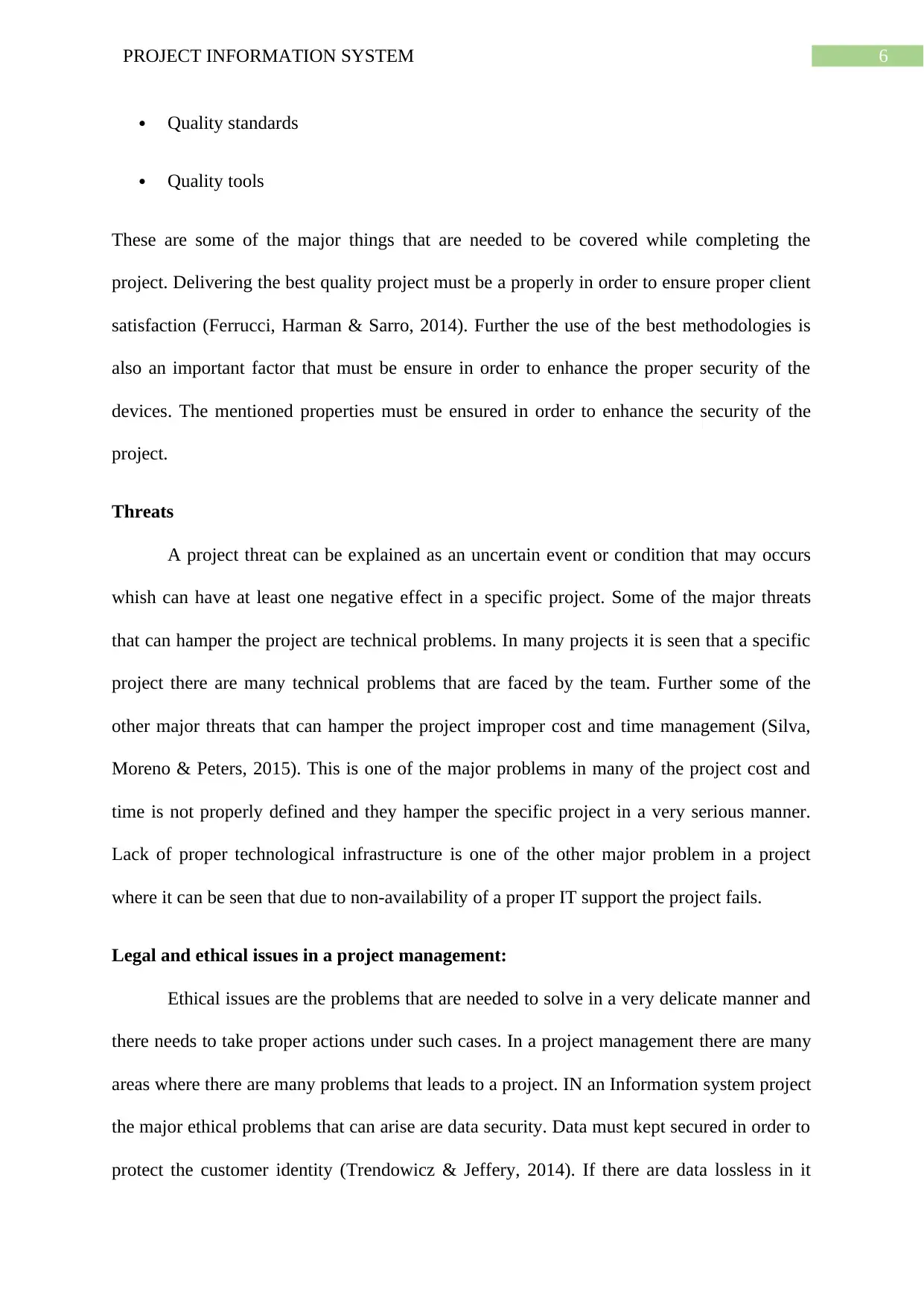
6
Quality standards
Quality tools
These are some of the major things that are needed to be covered while completing the
project. Delivering the best quality project must be a properly in order to ensure proper client
satisfaction (Ferrucci, Harman & Sarro, 2014). Further the use of the best methodologies is
also an important factor that must be ensure in order to enhance the proper security of the
devices. The mentioned properties must be ensured in order to enhance the security of the
project.
Threats
A project threat can be explained as an uncertain event or condition that may occurs
whish can have at least one negative effect in a specific project. Some of the major threats
that can hamper the project are technical problems. In many projects it is seen that a specific
project there are many technical problems that are faced by the team. Further some of the
other major threats that can hamper the project improper cost and time management (Silva,
Moreno & Peters, 2015). This is one of the major problems in many of the project cost and
time is not properly defined and they hamper the specific project in a very serious manner.
Lack of proper technological infrastructure is one of the other major problem in a project
where it can be seen that due to non-availability of a proper IT support the project fails.
Legal and ethical issues in a project management:
Ethical issues are the problems that are needed to solve in a very delicate manner and
there needs to take proper actions under such cases. In a project management there are many
areas where there are many problems that leads to a project. IN an Information system project
the major ethical problems that can arise are data security. Data must kept secured in order to
protect the customer identity (Trendowicz & Jeffery, 2014). If there are data lossless in it
PROJECT INFORMATION SYSTEM
Quality standards
Quality tools
These are some of the major things that are needed to be covered while completing the
project. Delivering the best quality project must be a properly in order to ensure proper client
satisfaction (Ferrucci, Harman & Sarro, 2014). Further the use of the best methodologies is
also an important factor that must be ensure in order to enhance the proper security of the
devices. The mentioned properties must be ensured in order to enhance the security of the
project.
Threats
A project threat can be explained as an uncertain event or condition that may occurs
whish can have at least one negative effect in a specific project. Some of the major threats
that can hamper the project are technical problems. In many projects it is seen that a specific
project there are many technical problems that are faced by the team. Further some of the
other major threats that can hamper the project improper cost and time management (Silva,
Moreno & Peters, 2015). This is one of the major problems in many of the project cost and
time is not properly defined and they hamper the specific project in a very serious manner.
Lack of proper technological infrastructure is one of the other major problem in a project
where it can be seen that due to non-availability of a proper IT support the project fails.
Legal and ethical issues in a project management:
Ethical issues are the problems that are needed to solve in a very delicate manner and
there needs to take proper actions under such cases. In a project management there are many
areas where there are many problems that leads to a project. IN an Information system project
the major ethical problems that can arise are data security. Data must kept secured in order to
protect the customer identity (Trendowicz & Jeffery, 2014). If there are data lossless in it
PROJECT INFORMATION SYSTEM
Paraphrase This Document
Need a fresh take? Get an instant paraphrase of this document with our AI Paraphraser

7
does not only harm the ethical issues of the organisation. This can also cause legal problems
for the organisation. IN the modern world the data thefts must be considered at highest
priorities as it can hamper the name of the organization. The organisation must ensure that
proper steps are taken so that there are less chances of any data security problems.
Closing phase in IS project:
The closing phase in any information system project is one of the most important
thing that is to be considered. The closing phase signifies the amount of the work done in a
project and also ensures that all the nessacery steps are taken in order to ensure proper
security of the project. Further the closing phase describes the whether all the components of
the project is working in the best manner possible or not. It also ensures whether the client is
satisfied with the project or not. In the closing phase all the required tests are to be done in a
proper manner such that there are no chances of any proper security of the devices
(Abdelaziz, El-Tahir & Osman, 2015). In the software projects there are final project testing
are to be done so that the before the project is live to public. Also there are too submitted with
the final document of the project. This is one of the most important phase where it is needed
to ensure that all the tasks are too completed in sort duration of time.
Conclusion:
Thus, concluding the topic it can be said that the information security is one of the
most important thing that is to be done in order to ensure proper working of the of the
organisation. There are many aspects of a project that are delicate and are needed to be
worked in a very serious manner such that the projects are completed in a much secured
manner. Before the project is completed several things are to be ensured in order to enhance
the project. One of the most important thing that is to be done is the proper documentation of
the project is to be ensure. Also there are some of the major ethical considerations that are
PROJECT INFORMATION SYSTEM
does not only harm the ethical issues of the organisation. This can also cause legal problems
for the organisation. IN the modern world the data thefts must be considered at highest
priorities as it can hamper the name of the organization. The organisation must ensure that
proper steps are taken so that there are less chances of any data security problems.
Closing phase in IS project:
The closing phase in any information system project is one of the most important
thing that is to be considered. The closing phase signifies the amount of the work done in a
project and also ensures that all the nessacery steps are taken in order to ensure proper
security of the project. Further the closing phase describes the whether all the components of
the project is working in the best manner possible or not. It also ensures whether the client is
satisfied with the project or not. In the closing phase all the required tests are to be done in a
proper manner such that there are no chances of any proper security of the devices
(Abdelaziz, El-Tahir & Osman, 2015). In the software projects there are final project testing
are to be done so that the before the project is live to public. Also there are too submitted with
the final document of the project. This is one of the most important phase where it is needed
to ensure that all the tasks are too completed in sort duration of time.
Conclusion:
Thus, concluding the topic it can be said that the information security is one of the
most important thing that is to be done in order to ensure proper working of the of the
organisation. There are many aspects of a project that are delicate and are needed to be
worked in a very serious manner such that the projects are completed in a much secured
manner. Before the project is completed several things are to be ensured in order to enhance
the project. One of the most important thing that is to be done is the proper documentation of
the project is to be ensure. Also there are some of the major ethical considerations that are
PROJECT INFORMATION SYSTEM
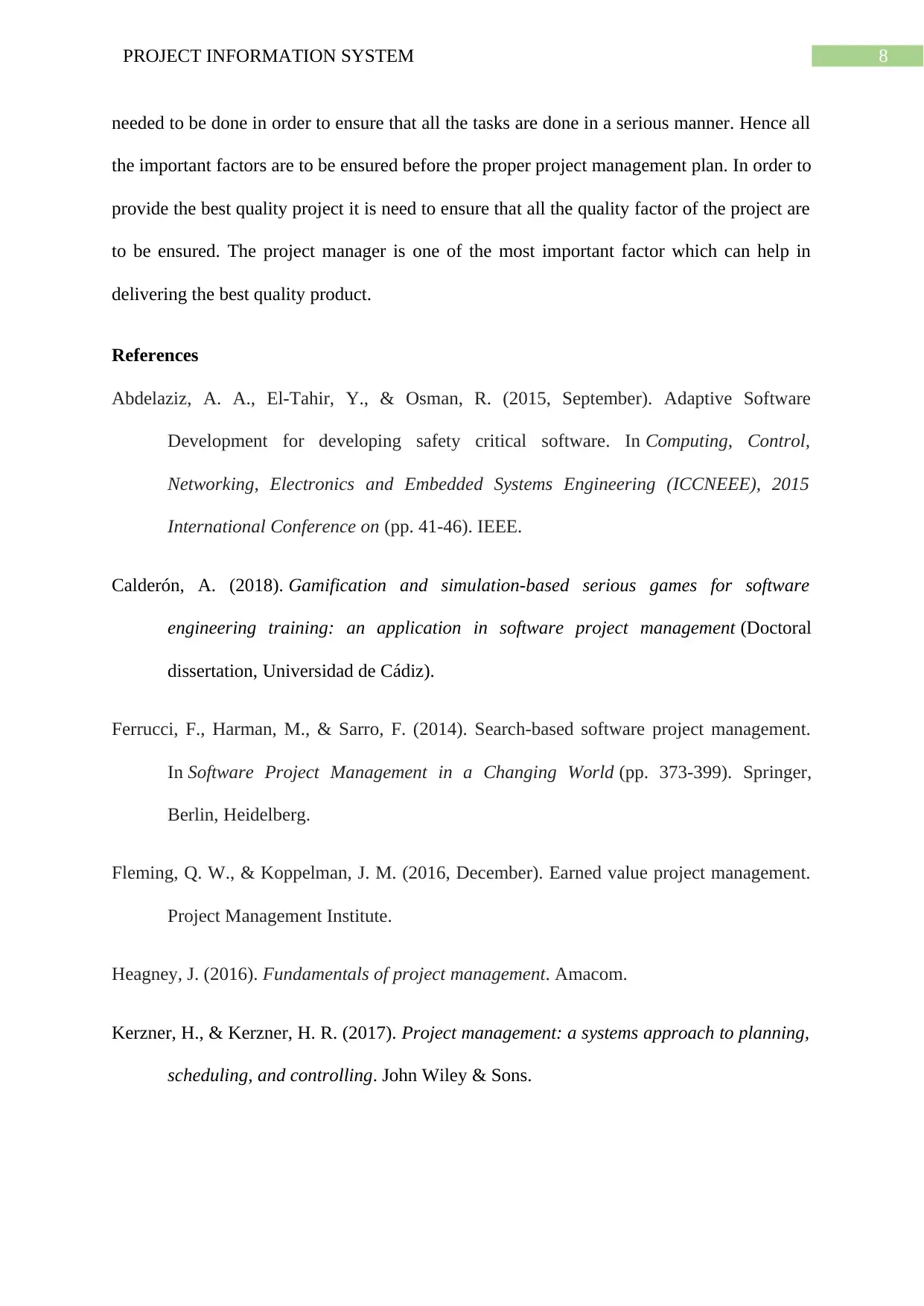
8
needed to be done in order to ensure that all the tasks are done in a serious manner. Hence all
the important factors are to be ensured before the proper project management plan. In order to
provide the best quality project it is need to ensure that all the quality factor of the project are
to be ensured. The project manager is one of the most important factor which can help in
delivering the best quality product.
References
Abdelaziz, A. A., El-Tahir, Y., & Osman, R. (2015, September). Adaptive Software
Development for developing safety critical software. In Computing, Control,
Networking, Electronics and Embedded Systems Engineering (ICCNEEE), 2015
International Conference on (pp. 41-46). IEEE.
Calderón, A. (2018). Gamification and simulation-based serious games for software
engineering training: an application in software project management (Doctoral
dissertation, Universidad de Cádiz).
Ferrucci, F., Harman, M., & Sarro, F. (2014). Search-based software project management.
In Software Project Management in a Changing World (pp. 373-399). Springer,
Berlin, Heidelberg.
Fleming, Q. W., & Koppelman, J. M. (2016, December). Earned value project management.
Project Management Institute.
Heagney, J. (2016). Fundamentals of project management. Amacom.
Kerzner, H., & Kerzner, H. R. (2017). Project management: a systems approach to planning,
scheduling, and controlling. John Wiley & Sons.
PROJECT INFORMATION SYSTEM
needed to be done in order to ensure that all the tasks are done in a serious manner. Hence all
the important factors are to be ensured before the proper project management plan. In order to
provide the best quality project it is need to ensure that all the quality factor of the project are
to be ensured. The project manager is one of the most important factor which can help in
delivering the best quality product.
References
Abdelaziz, A. A., El-Tahir, Y., & Osman, R. (2015, September). Adaptive Software
Development for developing safety critical software. In Computing, Control,
Networking, Electronics and Embedded Systems Engineering (ICCNEEE), 2015
International Conference on (pp. 41-46). IEEE.
Calderón, A. (2018). Gamification and simulation-based serious games for software
engineering training: an application in software project management (Doctoral
dissertation, Universidad de Cádiz).
Ferrucci, F., Harman, M., & Sarro, F. (2014). Search-based software project management.
In Software Project Management in a Changing World (pp. 373-399). Springer,
Berlin, Heidelberg.
Fleming, Q. W., & Koppelman, J. M. (2016, December). Earned value project management.
Project Management Institute.
Heagney, J. (2016). Fundamentals of project management. Amacom.
Kerzner, H., & Kerzner, H. R. (2017). Project management: a systems approach to planning,
scheduling, and controlling. John Wiley & Sons.
PROJECT INFORMATION SYSTEM
⊘ This is a preview!⊘
Do you want full access?
Subscribe today to unlock all pages.

Trusted by 1+ million students worldwide
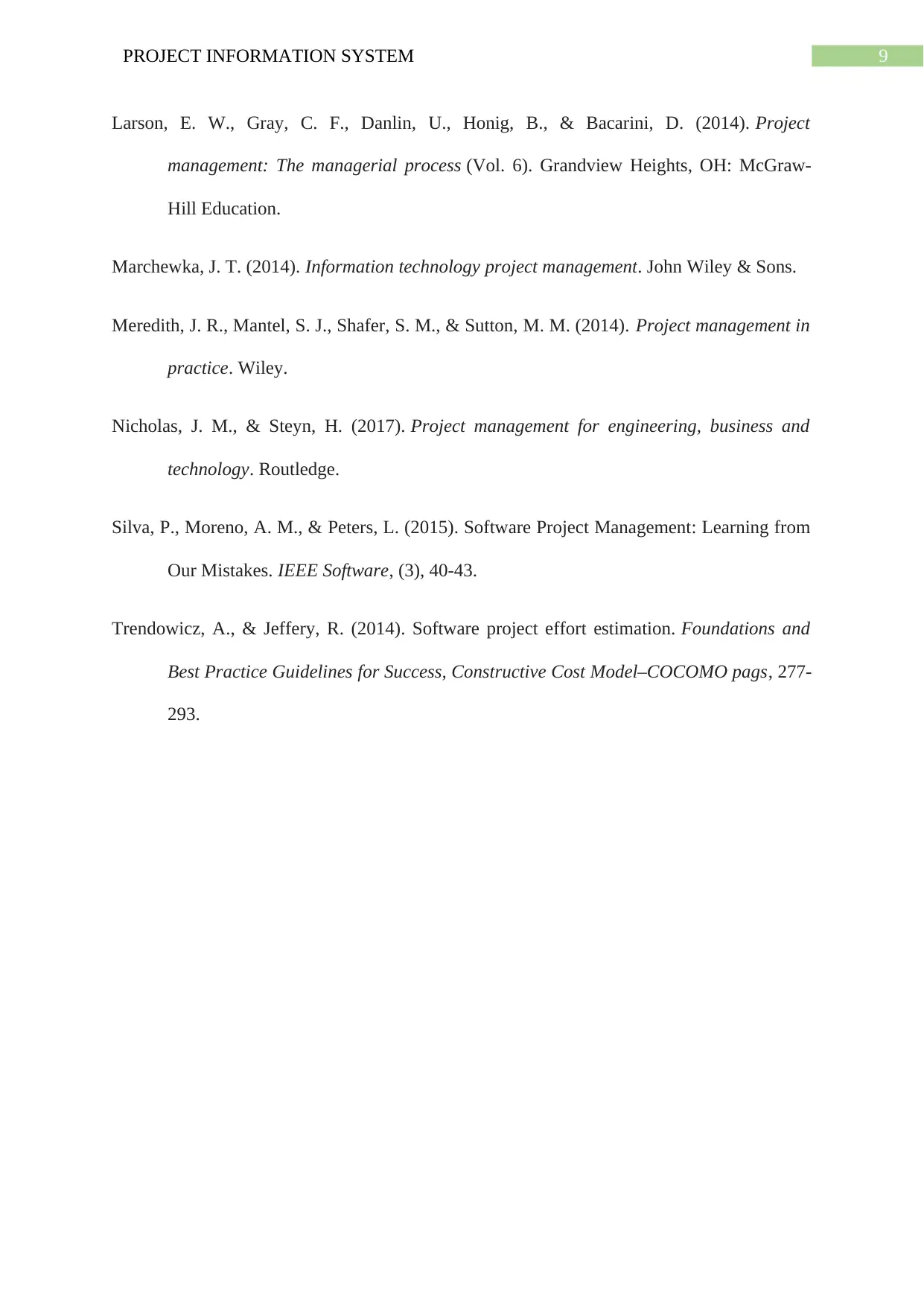
9
Larson, E. W., Gray, C. F., Danlin, U., Honig, B., & Bacarini, D. (2014). Project
management: The managerial process (Vol. 6). Grandview Heights, OH: McGraw-
Hill Education.
Marchewka, J. T. (2014). Information technology project management. John Wiley & Sons.
Meredith, J. R., Mantel, S. J., Shafer, S. M., & Sutton, M. M. (2014). Project management in
practice. Wiley.
Nicholas, J. M., & Steyn, H. (2017). Project management for engineering, business and
technology. Routledge.
Silva, P., Moreno, A. M., & Peters, L. (2015). Software Project Management: Learning from
Our Mistakes. IEEE Software, (3), 40-43.
Trendowicz, A., & Jeffery, R. (2014). Software project effort estimation. Foundations and
Best Practice Guidelines for Success, Constructive Cost Model–COCOMO pags, 277-
293.
PROJECT INFORMATION SYSTEM
Larson, E. W., Gray, C. F., Danlin, U., Honig, B., & Bacarini, D. (2014). Project
management: The managerial process (Vol. 6). Grandview Heights, OH: McGraw-
Hill Education.
Marchewka, J. T. (2014). Information technology project management. John Wiley & Sons.
Meredith, J. R., Mantel, S. J., Shafer, S. M., & Sutton, M. M. (2014). Project management in
practice. Wiley.
Nicholas, J. M., & Steyn, H. (2017). Project management for engineering, business and
technology. Routledge.
Silva, P., Moreno, A. M., & Peters, L. (2015). Software Project Management: Learning from
Our Mistakes. IEEE Software, (3), 40-43.
Trendowicz, A., & Jeffery, R. (2014). Software project effort estimation. Foundations and
Best Practice Guidelines for Success, Constructive Cost Model–COCOMO pags, 277-
293.
PROJECT INFORMATION SYSTEM
1 out of 10
Related Documents
Your All-in-One AI-Powered Toolkit for Academic Success.
+13062052269
info@desklib.com
Available 24*7 on WhatsApp / Email
![[object Object]](/_next/static/media/star-bottom.7253800d.svg)
Unlock your academic potential
Copyright © 2020–2025 A2Z Services. All Rights Reserved. Developed and managed by ZUCOL.



